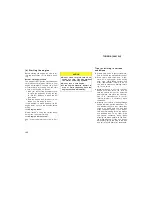
TUNDRA (34413U)
173
CAUTION
!
Do not pump the brake pedal if the
engine stalls. Each push on the
pedal uses up your vacuum reserve.
!
Even if the power assist is com-
pletely lost, the brakes will still
work. But you will have to push the
pedal hard—much harder than nor-
mal. And your braking distance will
be longer.
ANTI- LOCK BRAKE SYSTEM
(with “ABS” warning light)
The anti- lock brake system is designed to
automatically help prevent lock- up of the
wheels during sudden braking or braking
on slippery road surfaces. This assists in
providing directional stability and steering
performance of the vehicle under these
circumstances.
The anti- lock brake system becomes op-
erative after the vehicle has accelerated
to a speed in excess of approximately 10
km/h (6 mph). It stops operating when the
vehicle decelerates to a speed below
approximately 5 km/h (3 mph).
You may hear a sound in the engine
compartment for a few seconds when the
engine is started or just after the vehicle
is started. This means that the anti- lock
brake system is in the self check mode,
and does not indicate a malfunction.
Effective way to press the “ABS” brake
pedal: When the anti- lock brake system
function is in action, you may feel the
brake pedal pulsating and hear a noise.
In this situation, to let the anti- lock
brake system work for you, just hold the
brake pedal down more firmly. Do not
pump the brake in a panic stop. Pump-
ing the brake pedal makes the stopping
distance longer.
The brake pedal pulsation caused by the
anti- lock brake system may indicate haz-
ardous road surface conditions. Although
the anti- lock brake system assists in pro-
viding vehicle control, it is still important
to drive with all due care, because the
anti- lock brake system cannot overcome
the laws of physics that act on your ve-
hicle:
!
Braking capability is dependent on tire
friction with the road surface.
!
Even though the anti- lock brake sys-
tem is operating, a driver cannot main-
tain full control on certain slippery road
surfaces,
when
cornering
at
high
speeds, or in violent maneuvers.
!
Avoid high speeds on wet roads. The
anti- lock brake system cannot elimi-
nate the risk of hydroplaning and loss
of tire friction.
Always maintain a safe distance from the
vehicle in front of you. Compared with
vehicles not fitted with an anti- lock brake
system, your vehicle may require a longer
stopping distance in the following cases:
!
Driving on rough, gravel or snow- cov-
ered roads.
!
Driving with tire chains installed.
!
Driving on roads where the road sur-
face is pitted or has other differences
in surface height.
Содержание 2000 Tundra
Страница 10: ...TUNDRA 34413U 8 ...
Страница 20: ...TUNDRA 34413U 18 ...
Страница 78: ...TUNDRA 34413U 76 ...
Страница 86: ...TUNDRA 34413U 84 ...
Страница 96: ...TUNDRA 34413U 94 ...
Страница 146: ...TUNDRA 34413U 144 ...
Страница 154: ...TUNDRA 34413U 152 ...
Страница 166: ...TUNDRA 34413U 164 ...
Страница 182: ...TUNDRA 34413U 180 ...
Страница 200: ...TUNDRA 34413U 198 ...
Страница 226: ...TUNDRA 34413U 224 ...
Страница 232: ...TUNDRA 34413U 230 ...
Страница 244: ...TUNDRA 34413U 272 Fuse type C 39 ALT 120 A All components in AM1 ALT S HTR FR FOG PWR OUTLET 1 and PWR OUTLET 2 fuses ...
Страница 250: ...TUNDRA 34413U 278 ...
















































